The British Museum is a project of the Enlightenment. It is one of the oldest—older than both the Louvre and the Prado—and the biggest museums in the world. Its collection began when Sir Hans Sloane, a doctor and naturalist, bequeathed his private collection of “curiosities” to the state. The collection grew from there, with the goal of encompassing all of human history under one roof. And because the British Empire soon came to dominate half the globe, this ambition was not so ludicrous as it may at first appear. Ironically, you can probably find finer artifacts in the British Museum than in the countries that the exhibits represent.
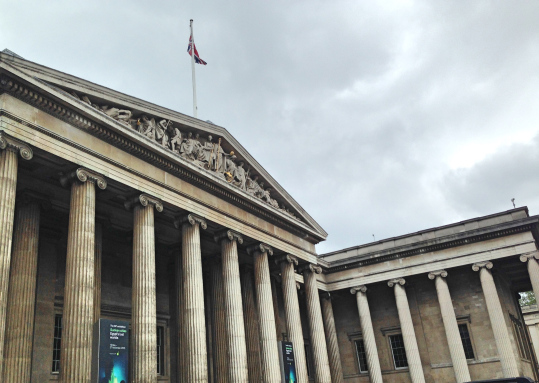
The museum’s massive collection is housed in an equally massive neoclassical building designed by Robert Smirke. Its collection is divided by era and area: Prehistory, the Ancient Near East, Ancient Egypt, Ancient Greece, South Asia, East Asia, the Americas, Africa, and Oceania. Wandering around the museum is like getting lost in a copy of a World History textbook brought to life. The collection is so vast and detailed that the visitor is simply overwhelmed. There is far too much information to take in and process in one visit—even in a dozen visits. Each artifact on display deserves deep study; and when each room is full of hundreds of these artifacts, there is not much you can do except dumbly gape. Likewise, there is not much a writer can do except emulate Sir Hans Sloane and collect curiosities.

I began in the Ancient Near East: Mesopotamia, the cradle of civilization. There is something sacred about the simple fact of age. Seeing ancient artifacts is the closest we get to time travel. The passing years corrode all material things, just as the gentle flowing of a stream eventually cuts through rock. The physical bodies of these ancients have long decayed; everything they knew and loved is gone. And yet, 5,000 years later, the messages they carved still preserve an echo of their voice.
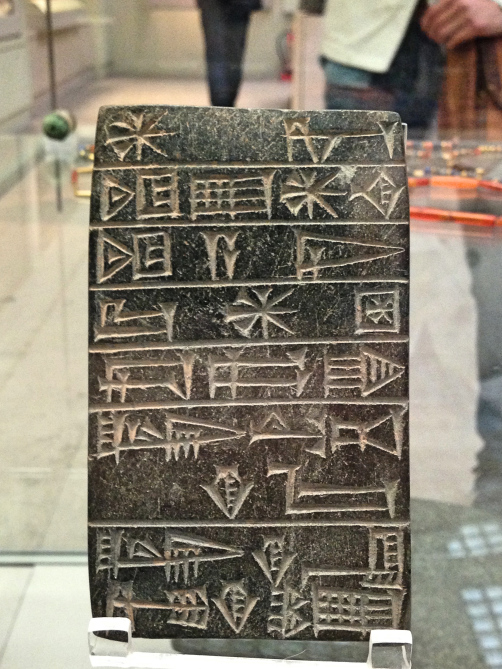
Every time I look at a cuneiform tablet—its crisscrossing wedges and lines unintelligible to me, but visibly a language—I find myself profoundly moved. For all I know, the message is a record of a banal commercial exchange—so many goats for so many bushels of hay—but the simple fact of writing something down, of imprinting words indelibly, signals the beginning of that noble and doomed war against time—the war we call ‘civilization’.
Seeing these first scratches in stone is like catching a glimpse of the universe a few seconds after the big bang. It marks the commencement of something entirely new in history: the ability to transfer knowledge across generations; to develop literature, philosophy, mathematics, and science; to create unchanging codes of law to fairly govern societies; to make the shadows of thought external and permanent. Less fortunately, the beginning of writing also marks the origin of bureaucracy and accounting—indeed, this seems to have been its original purpose, as communities grew too big to be governed by word of mouth.
Perhaps the most impressive object in this section is the Standard of Ur. (This is one of the objects chosen in Neil MacGregor’s series, A History of the World in 100 Objects. You can listen to the segment here. I wish I had read the accompanying book, which looks excellent, before my visit to the museum; it’s on my list.)
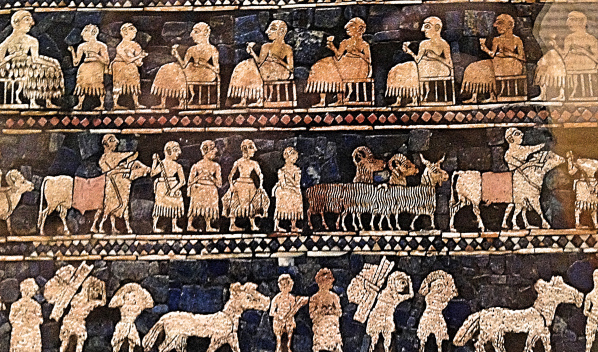 Detail from the Peace side
Detail from the Peace side
It is called a ‘standard’, but nobody really knows what it was used for: a soundbox for a musical instrument or a box to store money for sacred projects—who can say? All we can really determine is that it almost definitely was not a standard, since the drawings are too detailed to be seen from far away. The object dates from 2,600 BCE and consists of a box whose sides depict scenes of war and peace, in three lines of images that look like a comic book. On the war side, we see an army marching off to battle, with armored footsoldiers and men in chariots; below, these charioteers trample enemies underfoot. On the reverse side, we see men seated at a banquet, drinking, while a harpist and a singer provide background music. Below, men are herding animals and carrying sacks of goods on their back, presumably to offer them in tribute to the king.
This standard was found in the site known as the Royal Cementary of Ur, along with objects seen on both the War and the Peace side. Judging from the numerous skeletons in the tomb, it seems that the Sumerians had a practice similar to the Egyptians: upon the death of kings and queens, the royal attendants were put to death to serve their master in the afterlife. I always shudder when I hear about these practices. Drinking poison to follow your king in death seems to be the height of unjust absurdity. I feel angry on behalf of the attendants who lived in oppression and who did not even find freedom in their master’s death. And yet, despite my anger, I can’t help feeling a sort of awe at the level of devotion displayed by this practice. To identify so strongly with a leader that you follow them in death seems hardly human; just as an ant or a bee colony dies with its queen, so these human groups voluntarily put themselves to death.
Violence and oppression thus form the subject-matter of this artifact and surround its discovery. On one side we see the king marching off the war and killing enemies; on the other side the king enjoys the tribute of his hard-working subjects. Nowadays it is impossible to see the society depicted on the Standard of Ur as anything but monstrous: a predatory upper-class stealing from the poor, and then sending the lower-class off to war to defend their bounty and to capture slaves.
But it is worth asking whether the beginning of civilization could have been any different. Humans had just begun farming and forming cities. For the first time in the history of our species, we were living in large, permanent settlements alongside strangers. For the first time, we had enough resources to allow some people in the community to specialize in tasks other than gathering food: priests, soldiers, musicians, administrators, rulers, and artisans. The accumulation of resources always invites raids from without and crimes from within; and fending off these attacks requires organization, leadership, and violence. A community simply couldn’t afford to be anything but authoritarian and militaristic if it hoped to survive. It is an unfortunate fact of human history that justice and security are often at odds—a fact we still confront in the question of surveillance and terrorism.
As a parting thought, I just want to note how remarkable it is that we can look at something like the Standard of Ur—a luxury product made 5,000 years ago, by people who spoke a different language, most of whom couldn’t write, who had a different religion, who lived in a different climate, a people whose experience of the world had so little in common with our own, a people who lived just at the beginning of history—we can look at this object and find it not only intelligible, but beautiful. We experience this same miracle when we read the Epic of Gilgamesh—a story still moving, 4,000 years after it was written down.
In my first anthropology class we learned that humans are cultural creatures, fundamentally shaped by their social environment. But if this were true—if our inborn nature were something negligible and our culture omnipotent—wouldn’t we expect a civilization which flourished in such different circumstances to give rise to art that we couldn’t even hope to understand? And yet, so universal is the human experience that, 5,000 years later, we can still recognize ourselves in the Standard of Ur.
This constancy of our nature is not only manifested in great works of art. For me, the most touching illustration of this are the little baubles and trinkets, the sundry domestic items that give us a taste of daily life in that faraway age. We see the universal human urge to beautify our bodies demonstrated by the jewels of Ancient Greece, Persia, and Egypt, the rings, earrings, pendants, necklaces, armlets, and bracelets which still glitter and charm today—indeed, designs inspired by ancient examples can be bought in the museum store. We see this also in one of the oldest board games ever discovered, the Royal Game of Ur, whose game-board and game-pieces are instantly recognizable by the modern visitor. A cuneiform tablet has also been found which explains the rules, allowing scholars to play the game 4,500 years after its creation (though I can’t find out whether they enjoyed it).
Yet if the continuities are striking, so are the divergences. I feel the gap that separates the present from the ancient past most poignantly whenever I look at a papyrus scroll covered in Egyptian hieroglyphics. Fewer human artifacts look more alien to me than these bits of ancient writing. Lines of simple images—eyes, storks, sparrows, hawks, snakes, scarabs, and many I can’t recognize—run up and down the papyrus, in a parade of symbolic forms. On the top and in the corner are larger drawings, depictions of mythological scenes, illustrations of dead gods and long-forgotten myths. What is most striking is how the writing is a kind of picture, and the pictures a sort of writing; the visual and the verbal are combined into a web of meaning, absolutely saturated with significance.
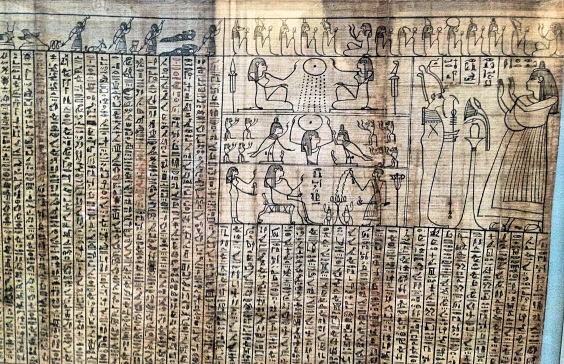
The thing that is so fascinating about the culture of ancient Egypt is that, for hundreds and thousands of years, through the rise and fall of dynasties and the passing away of dozens of generations, there is a unified, complete, and instantly recognizable aesthetic. It is immediately obvious to any visitor that they have entered the Egyptian section, whether in the first dynasty or the twentieth.
There is undoubtedly something terrifying about this continuity—terrifying that a society based on gross injustice persisted, with its culture nearly unchanged, for a span of time that dwarfs that of our own Western culture. But it is also easy for me to imagine the deep satisfaction enabled by such a complete mythology—a symbolic worldview that decorates every surface, imbues every hour of the day with importance, structures the year and explains the cosmos, penetrates into the depths of reality and even looks beyond the veil that separates life from death. I feel similar stirrings when I look at an illuminated manuscripts from our own Middle Ages, an artifact not so different from the Egyptian scrolls.

In any exhibition on ancient Egypt the mummies are always the stars—those shrunken, dried corpses carefully wrapped and sealed in stone sarcophagi to be sent down the eons. When I was there, a crowd was gathered around a mummy of a woman named Cleopatra, perhaps in the mistaken belief that she was Mark Antony’s famous paramour. Yet the most moving object in the Egypt section, for me, is the colossal bust of Ramesses II. (This was also featured on The History of the World in 100 Objects; you can listen to it here.)

Ramesses II was one of the most effective leaders in all of Egypt’s history. He was born about 1,300 years before the common era, and lived 90 long years, making his reign not only the most iconic, but the longest of ancient Egypt. An energetic general, statesman, and administrator, he was most of all a builder. He presided over the construction of dozens of colossal statues, temples, monuments, and palaces. It was this Ramesses who inaugurated the Abu Simbel complex, whose great temple includes four colossal statues (20 meters, or 66 feet high) of Ramesses himself, carved directly from the hillside. Ramesses was also responsible for the so-called Ramesseum, not a tomb, but a temple complex built for the worship of him, the deified Ramesses, during his reign and after his death.
The bust of Ramesses in the British Museum was taken from this Ramesseum. It is only a fragment: the base of the statue, in which the pharaoh is seated, is still in the Ramesseum. Napoleon’s troops first tried and failed to move the statue; then the British hired an Italian adventurer to do it, who used a combination of pulleys, hydraulics, and old-fashioned manpower. As Neil MacGregor notes, it is a testament to the power and ingenuity of the Egyptians that, 3,000 years later, their statues still require technical tours de forces to move. Imagine the discipline, organization, and sheer amount of sweat and backbreaking effort to move the original stone?
Cracked and battered as he is, the statue still has the effect that its creator intended: the impression of calm omnipotence. The pharaoh looks down serenely from a great height—imperturbable, immovable, eternal. Such a work is clearly the product of a culture in its prime, when artistic execution and social organization were raised to the pitch of perfection. As a mere display of technique, the statue is remarkable: the ability to transport such a massive block of stone, and then to chip away and polish the surface until all that remains is a perfect image of power. And you can imagine how effective these images were as propaganda, in a time before television or telescreens.
In life, Ramesses was as close as any human can get to complete power. In death, he was worshipped as a god. His name and his face have come down to us from over 3,000 years ago. This statue has outlasted whole kingdoms and countries; and there is a good chance it will keep persisting, even when (God forbid) the British Museum is no more. So you might say that, as propaganda, the statue has been an unmitigated success. And yet, Ramesses himself, his empire, and his entire culture—all of them have passed into memory, leaving only their stones and their bones. Impressive as the bust undeniably is, it is also undeniable that it now stands as a sample of Egyptian statuary, to be gawked at by visitors, impressed but certainly not worshipful.
All wood rots, all iron rusts, and everything human turns to dust. Shelley, upon hearing reports of this very bust of Ramesses II, put this sentiment into famous lines:
And on the pedestal these words appear:
“My name is Ozymandias, king of kings:
Look on my works, ye mighty, and despair!”
Nothing beside remains: round the decay
Of that colossal wreck, boundless and bare,
The lone and level sands stretch far away.
The final irony is that those immortal lines, like Ramesses’s bust, have outlasted their makers and will likely last as long as there are humans who worry about the finitude of life.
If there is any hope of immortality, it is through the communication of our ideas—something demonstrated most poignantly by the Rosetta Stone. That ancient document—an administrative decree about taxes and tithes—now stands in the British Museum as a testament to the ability of different cultures in different places and times to understand one another. In the modern world it has become trendy to agonize about the impossibility of translation and the gulfs that separate different cultural worldviews. But humans have been translating since the beginning of history; and the very fact that we can decipher a long-dead language, written in an archaic script, using another translation of an ancient language written in another archaic script, shows that communication can transcend wide differences of perspective.
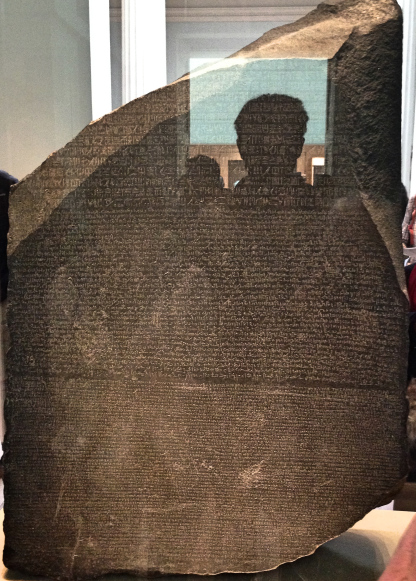 Photo includes a reflection of the writer in the glass
Photo includes a reflection of the writer in the glass
I have already spent far too much space describing the treasures of the British Museum. But I cannot leave off without a mention of the Elgin Marbles from the Parthenon.
The Parthenon, as everyone knows, is the most important and iconic ruin from Ancient Greece. Built during Athens’ golden age as a temple to their patron goddess, Athena, it has been both a church and a mosque in its long life. The Ottomans even decided to use the temple to store ammunition—guessing that their enemies, the Venetians, would never dare to fire at such a hallowed edifice. This guess was incorrect; in 1687 a Venetian bomb detonated the ammunition inside, causing a massive explosion that left only the building’s husk intact. Then in 1800 an art-loving British aristocrat, the Earl of Elvin, in highly dubious circumstances, excavated sculptures and friezes from the ruined Parthenon to decorated his home. But a costly divorce forced him to sell his home and his collection to the British government. As a result, the parts of the Parthenon, in the next chapter of their long and battered history, found their way into the British Museum.
Unsurprisingly, this acquisition is controversial. Imagine if a museum in England had a part of Mount Rushmore. Americans wouldn’t be happy, and neither are the Greeks. The Greek government has been trying to repossess the collection since 1983. There are many arguments averred for sending the marbles back to Greece. The most compelling is the simplest: that the Parthenon is one of the most important cultural monuments in European history, and should be as complete as possible. In any case, the legality of the original transfer has always been questioned: it’s possible that Elvin didn’t have official permission from the Ottoman Empire. In England, public opinion was divided at the time—Lord Byron famously thought it was inexcusable vandalism—and seems to be in favor of returning the collection nowadays. The British Museum is (also unsurprisingly) in favor of keeping the marbles.
For my part, it seems unquestionably just to return the Elgin marbles to Athens. I do admit, however, that I was grateful for the opportunity to see the Parthenon friezes in the British Museum. The display is excellent, allowing the visitor to clearly see the friezes and the statues. If the marbles were inserted back into their original places in the Parthenon (if this is even possible), then they wouldn’t be as clearly visible. And if the marbles were merely displayed in a museum in Athens, then I’m not sure there would be any improvement of presentation. Nevertheless, it does seem that strict justice demands that the marbles be returned.
As for the Elgin marbles themselves—the friezes, metopes, and pediments that line the wall of one enormous exhibit in the British Museum—what is there to be said? The sculptures are likely the most studied and analyzed works of art in Western history; and not only that, they are perhaps the most influential. Almost from the start these works have defined and illustrated classical taste. Indeed, the Parthenon has served as such a ubiquitous model for later artists that it is nearly impossible to respond to them as genuine works of art. They are immediately familiar; you feel that you’ve seen it all before, even if this is your first time in the British Museum.
To the modern eye, the Parthenon sculptures can appear cold, austere, and timeless—perfect human forms carved from perfect white marble. It is scandalous to imagine that these frigid sculptures were once painted with gaudy colors; and inconceivable that, once upon a time, these paragons of artistic orthodoxy were once innovative and daring works that broke every convention.
A visitor to the British Museum can catch a glimpse of the originality of these works if they visit the Babylonian and Egyptian sections first. Moving on from those precursors to the Greeks, you can see obvious continuities—heros and gods, mythological beings and legends, religious processions and rituals—but the changes are even more striking. In the Parthenon, we see a new thing in history: a confident belief in the powers of human intelligence and creativity. Unlike the static and rigid bodies of Egyptian pharaohs, sitting straight up and look straight ahead, we see bodies twisting, turning, leaping, extending, straining—in other words, we see the human body in motion, propelled by its own force. This is not a society that believes in stable order, but in ceaseless striving.
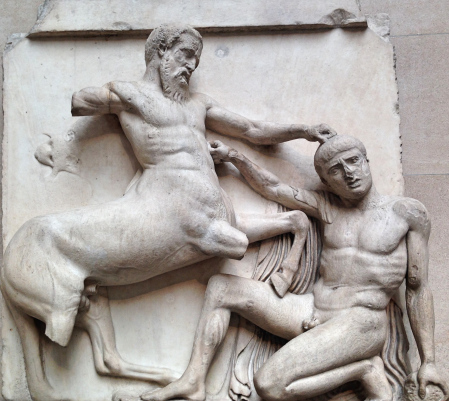
The new perspective is illustrated most clearly by the metopes depicting the centauromachy: the battle between the human lapiths and the half-human half-animal centaurs. In Egyptian mythology, many of the gods were half-animal; and Sumerian palaces were often guarded by the sphinx-like lamassus. In both of these cultures, the natural world, the world of animal life, was seen as a source of power and cosmic order. Yet in the Parthenon the half-animal creatures, the centaurs, are agents of chaos and destruction—creatures who must be conquered and vanquished. For better or for worse, this urge to conquer our own animal nature has been with us ever since.
There are so many more—thousands and thousands more—works that deserve deep contemplation in the museum’s collection, but I will stop here. Yet as I take leave of the British Museum, I want to leave you with one parting thought.
No institution I have seen better illustrates both the enormous strengths and the limitations of the Enlightenment than the British Museum. And because the Enlightenment is very much still with us, it is vital that we understand these strengths and limitations.
Its strengths are undeniable, especially in the context of history. As compared with what came before it, the conception of humanity and history embodied in the museum is undoubtedly an advance. Europeans began to be interested in non-Europeans cultures. Their sense of ancient history began to extend far beyond Ancient Greece and the tribes of Israel. Instead of focusing on their own country or their own religion, Europeans could conceive of humanity as a whole, with a single origin and a common destiny. The museum also demonstrates the democratic spirit of the Enlightenment. The knowledge is put on display for all to see and learn, not sequestered in schools or guarded by jealous academics. Just as the friezes of the Parthenon illustrate the confidence in human intelligence, so does the British Museum exemplify the new, boundless confidence in human reason—the belief that the world is intelligible, that we can communicate our knowledge to anyone, and that our knowledge is not bounded by creed, language, or nation.
But the museum also demonstrates the limitation of this universalist aim. For the idea of a museum that encompasses all of human history relies on the idea that we can create a neutral context in which to understand that history. This underlying notion is clear at a glance: each room—plain, white, full of right-angles—is filled with objects wrenched from their original context. Some of this context is restored, but only as information on panels. My question is: can a modern visitor, looking at a bracelet from ancient Egypt, reading about that bracelet on its accompanying caption, really grasp what this bracelet was to the jewel-maker who created it or the aristocrat who wore it? For comparison, imagine walking into a museum filled with objects from your room, except each object is carefully labeled and sits on its own display. Could any visitor understand what life was like for you?
My point is that there is something inescapably artificial and sterile about the museum. In attempting to create a universal history, a neutral context for information, the museum transforms its objects and imposes a new context. The original meaning of each artifact, how they were used and understood by their creators, is abolished; and instead, each artifact becomes a piece of evidence in a specifically Enlightenment story about the growth of humankind.
To put this another way, the Enlightenment attitude fails to come to grips with how our attempts to understand the world transform what we’re trying to understand. When knowledge is seen as impersonal, existing in a neutral context, simply a matter of seeing and describing, then knowledge becomes blind to its own power. And the British Museum is, among many other things, a demonstration of British power: the financial, political, and military means to scour the world and collect its most valuable objects into one location. It is also a demonstration of British intellectual power: the power to understand all of human history, to see truly and to interpret correctly, to escape provincialism into neutral universality.
I need to pause here. I sound as if I am being harshly critical of the British Museum, and indeed I am. But the truth is that my brief visit was staggering. I saw and learned so much in such a short time that I cannot possibly deny that I think the museum is valuable. The reason I level these criticisms at the British Museum is not because I think this intellectual project it represents is bankrupt or futile, but because, with all its flaws and limitations, with all its political and economic underpinnings, it seems to be the best we have yet achieved in humanity’s understanding of itself. I see these challenges not as reasons to despair—any intellectual project will have its limitations—but as spurs to creative solutions.
Advertisements Share this:




